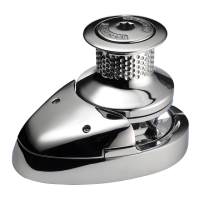Lewmar V1-6 Windlass ref 65001201 iss.8 | 37
MODEL
NORMAL
CURRENT
DRAW
TOTAL WEIGHT
GYPSY ONLY
TOTAL WEIGHT
GYPSY/DRUM
CIRCUIT BREAKER
A KG LB KG LB A
V1
112 19 42 - - 90
V1 MO
112 19 42 22 48.5 90
V2
121 19 42 22 48.5 90
V2
60 19 42 24.5 54 50
V3
131 21.5 47 24.5 54 110
V3
74 21.5 47 36 79 90
V4
125 29 64 36 79 150
V4
70 29 64 38 84 110
V5
120 31 68 38 84 150
V5
60 31 68 63 139 110
V6
60 60 132 - - 150
9.6 Electric specifications
MODEL
POWER
OPTION
MOTOR TYPICAL MAX. PULL MAXIMUM LINE SPEED TYPICAL WORKING LOAD
V W KG LB M/MIN FT/MIN KG LB
V1
12 700 750 1653 28 92 188 414
V1 MO
12 700 750 1653 28 92 188 414
V2
12 700 850 1874 29 95 213 470
V2
24 900 850 1874 29 95 213 470
V3
12 1000 1025 2260 39 128 257 567
V3
24 1000 1025 2260 39 128 257 567
V4
12 1600 1360 2998 25 82 136 300
V4
24 2000 1600 3528 27 90 136 300
V5
12 2000 1860 4100 27 90 136 300
V5
24 2000 2000 4410 29 97 136 300
V6
24 2000 1800 3960 16 52 450 990
10. Trouble shooting
1. Anchor rode pays out independently while windlass is not in use.
This problem is a result of not securing the anchor rode combined with the gypsy drive cap being slack.
Tighten the gypsy drive cap using the winch handle and always secure the anchor rode independently of the
windlass when not in use.
2. Failure to operate or sluggish operation.
The majority of these problems are electrical in nature. It is essential that the proper voltage be maintained.
The proper voltage on a 12 Volt system is 13.5 Volts (24 Volt system is 26.5 Volts), constant low voltage will
damage motor.
Ensure electrical cable size is large enough to handle the current draw and keep voltage drop within
acceptable limits.
Check control switches, connections, battery condition, isolator switch, fuse and motor for operation failure.
10.1 Electric windlass

